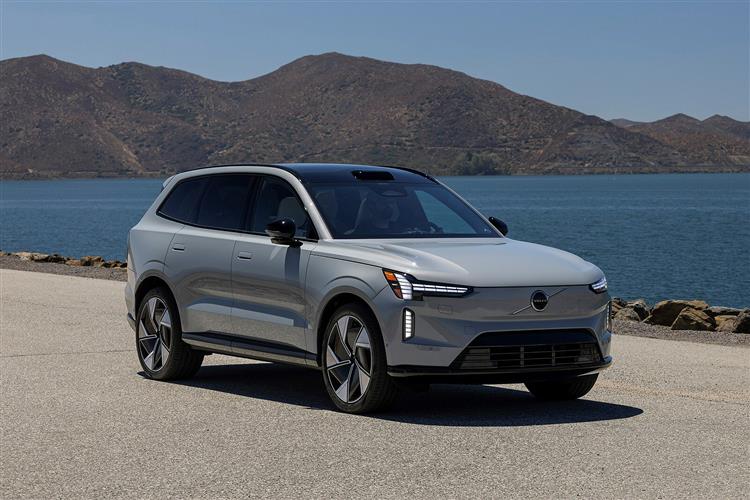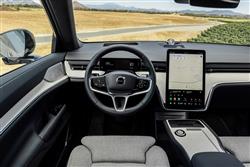This is a sample, and will stop after 30 seconds.
SWEDE WITH A MISSION (some text hidden) SECTIONED_new_volvoex90_2023_preview
By Jonathan Crouch
Volvo's EX90 is a large seven-seat luxury EV crossover that redefines its brand's future. Jonathan Crouch takes a look at the latest upgraded version.
Ten Second Reviewword count: 93
The EX90 is a large full-battery EV Crossover that has taken Volvo into a new era. As the company puts it, 'it's a statement for where we are - and where we're going', combining the brand's own engineering advances with 'the best technology from the world's best technologists'. This SUV is also one of the few large super-luxury EVs to be able to seat seven. It's an ambitious statement of intent from the Sino-Swedish brand. And now that this car has a proper 800V electrical architecture set-up, it's certainly worth a second look.
Backgroundword count: 279
What does the future really look like for large luxury cars? Various brands have told us, but none of them are approaching that future quite like Volvo, the company proudly styling itself as 'a pioneer in the protection of people and planet'. A claim embodied most clearly in what was the first of the company's EVs to sit on a dedicated electric platform, this EX90. The original plan was for this to be the replacement for the combustion-powered XC90 large SUV model line that saved Volvo at the turn-of-the-century, though thanks to the slow pace of the EV revolution, that fossil fuelled model will now continue for several years yet. The future for flagship Volvos though, lies with EVs produced off the parent Geely Group's advanced SPA2 architecture, a platform already used by the EX90's close cousin, the Polestar 3 - and also by Volvo's similarly-sized ES90 saloon. Both cars share the same drive system and much else with this EX90, but this big Volvo SUV differs from those two other cars in its provision of three seating rows. The EX90 was first announced way back in 2023, but delay after delay meant that it didn't start filtering into UK showrooms until early 2025. In a form with an old-tech 400V electrical architecture and an older-tech Nvidia Xavier chip. We advised potential customers to wait for the properly upgraded Model Year 2026 version, which got a much faster-charging 800V electrical system and a considerably faster Nvidia Drive AGX Orin processor. As before, the car is built at the company's US plant in Charleston - and eventually be made at Chengdu in China too, with both plants rated carbon neutral.
Engines and Tech Specword count: 296
There are three powertrains on offer here. Things kick off with a Single Motor rear-driven model with a 279hp motor with 490Nm of torque energised by a 100kWh battery with 380 miles of range. Otherwise, your EX90 will be of the Twin Motor All-Wheel Drive sort, with a choice of two output levels. Standard models offer 408hp, while 'Performance' variants up that to 517hp. In both cases, power comes from a 111kWh battery, which delivers a range of 384 miles in the base model and 374 miles in the 'Performance' version. As with all Volvos, top speed is limited to 112mph. The 62mph from rest sprint takes 5.9s in the Twin Motor model, improved to 4.9s by the 'Performance' version. All of this we've seen before in the Polestar 3. The EX90 though, gets a standard feature that is only optional on that car, the 'Lidar sensor'. That gives you a combination of powerful silicon chips, sensors and Volvo-developed perception software so powerful that the brand refers to it as 'a digital seatbelt'. And promises it'll reduce accidents involving death and serious injury by 20%. The Lidar sensor also provides everything necessary for this Volvo to drive itself fully autonomously, as soon as worldwide legislation permits it. We've heard that before of course, but Volvo wasn't sure that earlier autonomous drive systems could match its exacting safety standards. So it's developed its own autonomous drive set-up, with a completely new level of hardware, software and processing power; including Nvidia processors and Qualcomm CPUs combining to process up to 280 trillion operations per second. Forget performance figures: these are the kinds of stats that are really going to matter in luxury cars going forward. This one nails them more directly than any rival has done to date.
To see the full road test text contact us on 0330 0020 227
Pictures (high res disabled)

.jpg)
|
.jpg)
|
.jpg)
| |||
.jpg)
|
.jpg)
|
.jpg)
| |||
.jpg)
|
.jpg)
|
.jpg)
| |||
.jpg)
|
.jpg)
|

|
Statistics (subset of data only)
Min |
Max |
|
Price: |
£82,660.00 (At 26 Sep 2025, Single Motor) |
£99,960.00 (At 26 Sep 2025, Twin Motor Performance) |
Max Speed (mph): |
112 |
|
0-62 mph (s): |
4.9 (Performance) |
|
Electric WLTP-Rated Driving Range (miles): |
380 |
|
Length (mm): |
5037 |
|
Width (mm): |
1964 |
|
Height (mm): |
1744 |
|
Boot Capacity (l): |
310 |
1915 |
Power (ps): |
279 (Single Motor) |
517 (Performance) |



